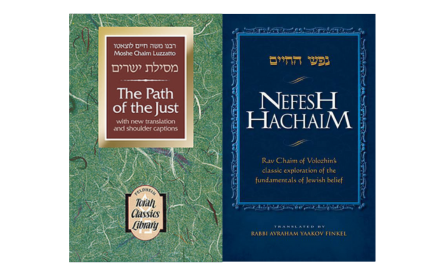Letters to the Editor
Many thanks to those who have shared feedback and thoughts regarding my original article. I would like to continue the conversation hosted here by responding to Yaakov Resnik and R. Chaim Goldberg.
Yaakov Resnik first challenged my presentation of Mesilat Yesharim, wondering how what sounds like a shelo lishmah orientation—keeping Torah and mitzvot with a focus on the World to Come—could be taken as an essential worldview. (In fact, a different respondent shared a piece from Rav Dovid Cohen of Chevron Yeshiva addressing exactly this point—with recourse, interestingly, to Nefesh Ha-Hayyim. See Maskil Le-David 17.) Instead, Resnik suggested Nefesh Ha-Hayyim as a more appropriate source for the “Torah only” worldview, drawing from the fourth section of the sefer to state that “Torah is the telos of all creation.”
R. Chaim Goldberg took issue with my characterization of Ramhal’s position in Mesilat Yesharim. Citing other sections of Mesilat Yesharim, Goldberg argued that my presentation did not accurately capture Ramhal’s approach in that work. Additionally, he pointed out that the contemporary musar yeshivot, which ostensibly are the places most likely to adhere to Ramhal’s perspective, conform the least to my presentation of what lies at the base of their presumed worldview. Instead, Goldberg, like Resnik, suggested that Nefesh Ha-Hayyim might contain the premier representation of the Torah Only camp’s perspective.
While there is much to address in both responses, I would like to focus on the common denominator. Both respondents suggested that Nefesh Ha-Hayyim can be more accurately identified as the source of the Yeshivish worldview. (Of course, there was no conference at which the “yeshiva world” came together and chose either Ramhal or Nefesh Ha-Hayyim, but since both works are fundamental in the traditional yeshiva community, either could be a candidate for the position I initially ascribed to Ramhal.)
Yet, what I will show in this response is that adopting Nefesh Ha-Hayyim as the source of the Yeshivish worldview still leads to a parallel conclusion that, while not identical to my initial conclusion, is practically quite similar, a point Goldberg perspicaciously made in his article.
If we start at the beginning of Nefesh Ha-Hayyim, rather than jumping to the more well-known fourth section, the author presents the essence of his worldview, namely, that we are meant to repair and uplift the Upper Worlds, known in Kabbalah as the worlds of atzilut, beri’ah, yetzirah, as well as repair our world, known as asiyyah.1 Only Jews have the power to make an impact on such a cosmic level, which is indicated by the label “tzelem Elokim.” Nefesh Ha-Hayyim states: “And this is the meaning of, ‘And Elokim created man in His image…’ … that just as He, may His name be blessed, is Elokim, the Master of the forces in all the worlds and the one who arranges and directs them at every moment according to His will, so too His will, may it be blessed, enthroned man to be the one who opens and closes many tens of thousands of forces and worlds, according to his actions in all areas at all times… as if he, too, is the master of these forces, in a manner of speaking.”2
This cosmic impact is practically accomplished through the performance of mitzvot. Nefesh Ha-Hayyim posits that every human limb corresponds to some facet of the Upper Worlds. Thus, “When a person fulfills the will of his Master, may His name be blessed, and fulfills with some limb and its force one of Hashem’s mitzvot, the repair relates to that world and upper force that corresponds to it, to repair it, or to raise it up, or to add light and holiness to its present sanctity… according to the way it was performed, and according to how purified and sanctified his thoughts were at the time of performance, which joins the action itself… and from there, holiness and vitality are drawn down onto the force that fulfilled the corresponding Divine command.”3
While Nefesh Ha-Hayyim initially sounds like he sets out a parallel goal to Rav Soloveitchik—to repair the world, to “partner with Hashem in the creation of the world” (a midrash he quotes or references a number of times throughout the sefer), his meaning is very different. Whereas Rav Soloveitchik used it in a very exoteric, this-worldly way, by applying the laws and values of the halakhic system to this world, Nefesh Ha-Hayyim uses it to mean that one can impact all of the worlds on the spiritual plane through the performance of mitzvot.
With this background, the significance of talmud Torah can be understood in context. Nefesh Ha-Hayyim dedicates the fourth section of his work to discussing the importance of talmud Torah. Based on the kabbalistic teaching that “Hashem and His word are one,” just as Hashem enables all of the worlds to exist, human involvement in learning Torah is absolutely necessary for all of the worlds to survive.4 As is well-known, Nefesh Ha-Hayyim declared that if there was ever a moment in which no Jew was learning Torah throughout the world, it would revert to its primordial state of nothingness. To avoid this, it is said that he instituted learning shifts throughout the night in the Volozhin Yeshiva to ensure that such a thing would not happen. Because the Torah is so closely connected to Hashem Himself, as the expression of His will, it has the unique ability to not only repair and uplift individual forces and worlds, but to stretch all the way back to the source of the highest world and uplift it from its very root and essence.
As I quoted in the original article, the Centrist approach sees the juggernaut status of talmud Torah as being rooted not in its metaphysical impact on all of the Upper Worlds, but on the guidance it gives us in building and navigating this world, olam ha-zeh.
Thus, while both Nefesh Ha-Hayyim and the Centrist thinkers describe a program of “repairing the world,” the practical applications are very different. The Centrist approach is to focus on olam ha-zeh, using the Torah’s guidance to make a world that can play host to the Shechinah. Nefesh Ha-Hayyim’s approach, on the other hand, is to direct one’s attention to the Upper Worlds, discounting the challenges of this world in favor of repairing the metaphysical breaches and breakdowns of the olamot ha-elyonim, the Upper Worlds. If Ramhal presents a split between olam ha-zeh and olam ha-ba, Nefesh Ha-Hayyim focuses on the split between olam ha-zeh and the olamot ha-elyonim. While these approaches are of course different, they lead practically to the same thing: one should perform mitzvot, avoid aveirot, and learn as much Torah as possible.
A Centrist thinker unquestionably affirms the value of all three activities; he simply adds that one’s overall orientation should be to use those activities in pursuit of the broader, more encompassing goal of remaking the world according to the Divine blueprint. To give one practical example, a Centrist thinker would encourage a person to invest in a career that allows him to express Divine values in practical life, informed by the sugyot that address those values, as opposed to taking a job only on the basis of its salary and the hours on the job away from a sefer.
To conclude, and as I said in the original article, I am not attempting to establish “better” and “worse” or “right” and “wrong.” There are sources to support both sides; Nefesh Ha-Hayyim, in particular, quotes a breathtaking number of sources to support his position, especially from the world of Kabbalah. Rather, I am looking to clarify the different approaches to avodat Hashem in two of our communities and the practical ramifications of those differences.
May we all merit to serve Hashem in an ideal manner.
1 In addition to the sources cited below, see R. Chaim Volozhin’s Likutei Ma’amarim 1.
2 1:3.
3 1:6.
4 See 4:9-11.










 Site Operations and Technology by The Berman Consulting Group.
Site Operations and Technology by The Berman Consulting Group.